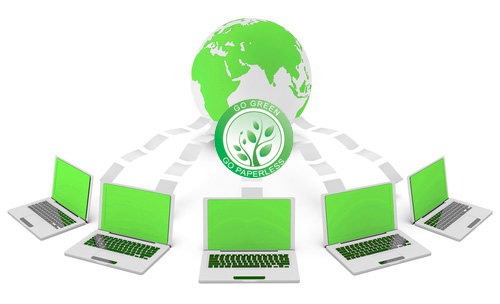G|I|S - Go Paperless
Is Your Organization Planning to Go Paperless?
 ECS-Unified is one of the system solutions that GIS utilizes to help organizations develop paperless offices.
ECS-Unified is one of the system solutions that GIS utilizes to help organizations develop paperless offices.
Before looking into software solutions that are needed to electronically transact business processes, it is advised that a clear process overview description and associated paperless policy be drafted which
will lead towards the right goal.
Developing a policy to go paperless is by far the simplest part of the transformation process. Understanding the existing processes and implementing the right policy could be a complex undertaking. An organization may chose to start combating such an undertaking one process at a time. .
An organization planning to go paperless should define a clear schedule to accomplish a paperless office and draft a detailed plan to stick to the schedule. The effort should also be quantified through the amount of files digitally converted in a day, or number of hours spent scanning during the course of a day. An organization may also choose to compare the estimated effort with cost savings during short-term and long-term utilizations.
The process of such transformation can be initiated by setting aside few hours a day for scanning archived physical documents into a digital form and setting a goal to scan specific amounts of files a day.
These could be all at one time or spread throughout a time-period and are very important steps.
The advantage of starting with small steps is that it will lead into a momentum that will eventually start to help chip away at any paper
laden work environment. A particular organization may be able to accomplish more or less than another similar organization depending on the
business process at hand, drafted paperless policy and overall paper utilization. Better results can also be achieved through the implementation of appropriate smart electronic
process management systems.
A common misconception when starting out to implement paperless is thinking it is better to start out without a clear plan and just go at it by simply opening a file bin, processes the applicable documents thru scanners, and let the scanners digitize all of them into the bin.
Going paperless for the most part is a process that requires proper planning and clearly defined goals with set of milestones.
One example of inefficiency arising from the common misconception is that many implementers forget that the mammoth amount of paper or documents within some of the archived physical files does not need to be scanned because they are outdated, obsolete or redundant. Why make a digital copy of something that will never be needed, isn't required by compliance or already available in a digital form online.
These types of thoughtful planning are eye opening and make organizations realize that the notion of becoming paperless is much more involved
than just a simple policy or activity. Organizations must properly draft a very extensive plans in order to effectively become paperlessly organized. Each paper artifact or type must be screened
for importance prior to being scanned.
An added cost of scanning useless documents aside from wasted time is it could make searching for specific information at a later time much harder.
Now maybe the right time for your organization to start planning to be prudent with those bloated physical paper bins. Do you think your organization could benefit from paperless office?
The thought of organizations being prudent about a bunch of paper files may sound comical, but when you see the final cost savings and how efficient the organizations'
processes could become, it has serious benefits.
This is one of the improvement areas where being echo-friendly could be becoming cost savvy and information relevance prudent.
The single most time consuming task at the outset will be digitizing the organization physical paper files. Eventually most of the new incoming data
could be made to be digital and very soon, less and less paper feed will be part of business processes.
Below are some simple policy tips to help you carve a paperless office:
1) Make digitizing tools available to your staff and start utilizing applications such as pdf compilers, Word converters, etc.
2) Install printer drivers that will print to a digital file in a pdf or word format.
3) Implement fax to email and email to fax services in your organization.
4) Utilize e-signatures or secured digital document signing for contracts and approvals.
5) Create and deploy web-forms to collect input as opposed to paper copies
6) Choose to utilize emails and document workflow tools instead of hand-delivering physical paper copies within your organization.
7) Utilize and make available digital document library that can encourage digital document usage with features such as filtering,
classifying, versioning, etc.
GIS has experience in helping large organizations to become paperless business organizations. How can we help you?
